what if I'm a crowded desert? too much pain with little pleasure
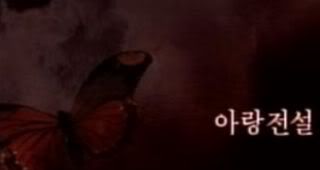
Along with, I suspect, easily a third of other Americans, I have a Netflix account. And Netflix has a fairly insanely varied list of films that can be watched online, without having the discs sent to my home. (This suits me, because I watch a lot of films, and it suits them, because I still pay them and they don't have to ship as much to me, so it's a win-win situation.)
But I've been trying to catch up on my Asian horror selections, and one of them I've wanted to see for some time is the South Korean film Arang.

Now, Arang at first glance seems your typical (Japanese, at least) Asian horror film--there is the expected long dark hair, there are the expected flashes of crazy eyes, there is an intensely creepy child who stalks men for no reason. All of these are becoming common images, familiar tropes at this point. And well they should be--they generally indicate frightening spirits of vengeance in Asia, thin hungry wraiths with lank dark hair, sometimes wet, and clawed or bleeding hands and eyes--so far sunk into mad rage that they inflict harm on anyone they come in contact with.
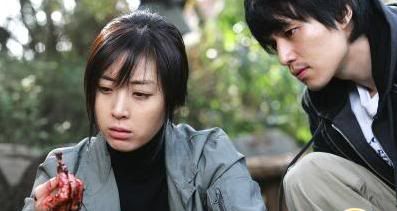
And I will say it's perhaps an overly ambitious film, for what it's trying to do; on top of that, it expected a lot of its audience, and (at least in the English translation) never bothered to translate any emails sent to characters (a large plot of the film), nor the end "tale of the legend" behind the name at all.
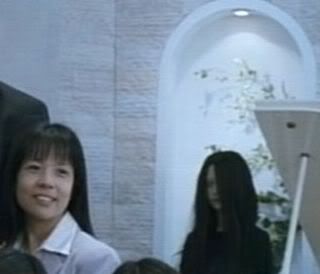
But the film is actually much deeper than that, and knowing more about it, makes it that much more frightening.
Arang was the daughter of a magistrate in the Miryang region of Korea, during the time of the early Joseon Dynasty. In a very odd twist on the 'kingmaker' legend, her governess--apparently seeking to overthrow the local power structure--hired a servant named Baekga to kidnap Arang and rape her, thus preventing her from marrying into a good family to strengthen her father's political alliances.
But Arang was the prototypical 'good girl'; she struggled with Baekga, refuting his advances, and in the struggle, he stabbed her to death. She died, her hair and clothing in disarray, bloodstains on her rent garments.
Now, for whatever reason (my personal belief is either Baekga or the governess burying her body without being detected, to encourage the story of Arang running away), her father thought she had eloped with a strange man, and he suffered a deep and crippling sense of shame from her actions. Soon after, he resigned his position as magistrate.
But here is where Arang's vengeance comes into play. The governess conspired to appoint a new magistrate, and that magistrate was confronted one night with the daunting image of the slain Arang, screaming her vengeance for her ruin. He fled the magistrate's house and the position. And after each magistrate was elected to this region, Arang would appear, and terrify the new man chosen into quitting. For more than ten years this went on, until the election of Yi Sang-sa, who was brave enough to survive Arang's visitation, and swore to her spirit he would avenge her.
He tracked down Baekga and the governess, and they led him to the body, mysteriously preserved; whereupon he had both arrested, and that seemingly brought Arang peace.
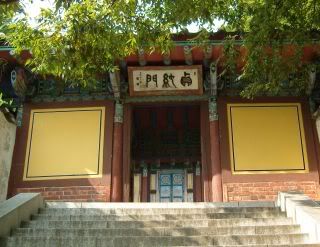
(The front gates of the Aranggak Shrine in Miryang.)
There is still a shrine that stands in Miryang, called Aranggak, where offerings to her spirit are made. While the official rites are no longer celebrated, for centuries rites specifically to her were held on the sixteenth day of the fourth month on the Chinese calendar.

(Behind the altar of the Aranggak shrine in Miryang; a painting of Arang.)
It sits on the rise of Yeongnamnu, above the Miryang River, and even though official celebration days have ceased, she is still honored for her virtue and for her strong will and perserverance.
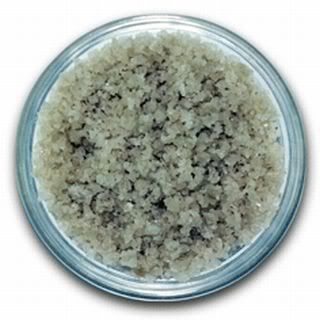
There is some odd link in all of this to Korean bamboo salt (not to be confused with bamboo rice) as well, an intriguing beauty aid produced in China and South Korea. The trick is simple: hollow out a stalk of bamboo; fill it with coarse-ground salt; then seal the ends and roast it slowly, nine times. Nine times apparently pulls out the bulk of whatever's beneficial in bamboo into the salt; it also darkens the salt to a fleur de sel grey.
Why is this relevant? Because it's purported to be such a great healing agent, able to reverse aging, to whiten and lighten the skin; it's frequently found anywhere from shaker form (for people to carry with them, and shake a bit on everything they consume, from snack foods to desserts) all the way to milled soap (and apparently there are companies encouraging people to use the salt alone as a bath additive, because it both 'cleans and purifies'), and everything in between.
And, since much of the film's action centers on the mysterious salt warehouse, it's one odd subconscious clue to the perversion of bamboo salt's curative powers, so even that Korean tradition aids in understanding of the film.

Even that is not where we stop in trying to better appreciate Arang; because this film is not the typical supernatural horror flick. It has a surprising amount of heart, and, beyond that, it's a morbidly effective crime drama on its own merits. If we stripped out every paranormal detail, Arang would still be enjoyable because it's so sharp--why was the lead detective suspended? Why was her new rookie partner transferred from the city? Who's behind the unnerving website that each of the victims visited before dying?
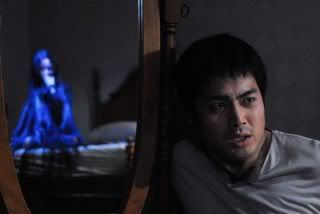
And then take one step farther back from that and ponder deeper questions: is it wrong to become a police officer out of vengeance, for example? Is it wrong to become a police officer because you've made mistakes, and you want to fix them? Can a woman who's been raped ever love again? How close do mothers tie to their children? How close do fathers?
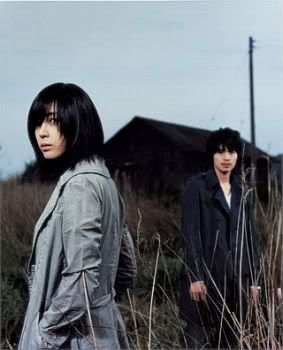
Ultimately, after everything, the last question is simple: what haunts us? Are our strongest haunts something other people give us...or do we ourselves store those terrors in our own heads? Arang is the story of people, and the choices, good and bad, that propel them forward. And it functions excellently on that level, as well.
Stephen King once said that being a true horror movie fan means we see a lock of shlock horror between the really great films. And if we're true horror buffs, we learn to relish the shlock along with the stellar pieces, not only because there's so much more of it, but because sometimes earnestness of heart counts, and we can see the edges of the film the makers were trying to record on celluloid. And sometimes, that's enough.
But he said that there's always a moment, and sometimes even in the cheapest, most ridiculous films, where the sudden heart-pounding terror rings like the finest lead crystal; whereas the bad moments will clunk and thud like the cheapest factory glass. "You can drink your Dom Perignon out of either one," he said, "but friends, there is a difference."
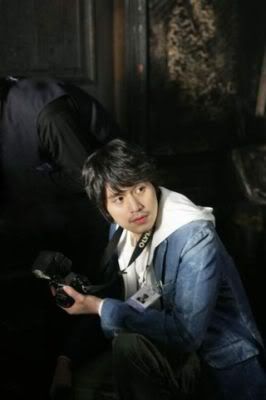
Well, this may not be Dom Perignon out of a Flinstones jelly jar; the production quality is slick, there's a palpable scent of money behind this one, and money well spent (at least until the translation budget, which I swear the producers spent on dancing girls and beer, because the translations are ABYSMAL). But I will say there are more than a few moments I heard crystal ring, and if you're willing to put up with a bit of plot confusion, and some (by now) highly recognizable Asian horror moments...I'm pretty sure you won't be disappointed. And you'll also detect the ringing of fine crystal embracing horror's finest.
At the very least, if you have a Netflix account...watch it there. It's not like you're out anything more for the month.
There is still a shrine that stands in Miryang, called Aranggak, where offerings to her spirit are made. While the official rites are no longer celebrated, for centuries rites specifically to her were held on the sixteenth day of the fourth month on the Chinese calendar.

(Behind the altar of the Aranggak shrine in Miryang; a painting of Arang.)
It sits on the rise of Yeongnamnu, above the Miryang River, and even though official celebration days have ceased, she is still honored for her virtue and for her strong will and perserverance.

There is some odd link in all of this to Korean bamboo salt (not to be confused with bamboo rice) as well, an intriguing beauty aid produced in China and South Korea. The trick is simple: hollow out a stalk of bamboo; fill it with coarse-ground salt; then seal the ends and roast it slowly, nine times. Nine times apparently pulls out the bulk of whatever's beneficial in bamboo into the salt; it also darkens the salt to a fleur de sel grey.
Why is this relevant? Because it's purported to be such a great healing agent, able to reverse aging, to whiten and lighten the skin; it's frequently found anywhere from shaker form (for people to carry with them, and shake a bit on everything they consume, from snack foods to desserts) all the way to milled soap (and apparently there are companies encouraging people to use the salt alone as a bath additive, because it both 'cleans and purifies'), and everything in between.
And, since much of the film's action centers on the mysterious salt warehouse, it's one odd subconscious clue to the perversion of bamboo salt's curative powers, so even that Korean tradition aids in understanding of the film.

Even that is not where we stop in trying to better appreciate Arang; because this film is not the typical supernatural horror flick. It has a surprising amount of heart, and, beyond that, it's a morbidly effective crime drama on its own merits. If we stripped out every paranormal detail, Arang would still be enjoyable because it's so sharp--why was the lead detective suspended? Why was her new rookie partner transferred from the city? Who's behind the unnerving website that each of the victims visited before dying?

And then take one step farther back from that and ponder deeper questions: is it wrong to become a police officer out of vengeance, for example? Is it wrong to become a police officer because you've made mistakes, and you want to fix them? Can a woman who's been raped ever love again? How close do mothers tie to their children? How close do fathers?

Ultimately, after everything, the last question is simple: what haunts us? Are our strongest haunts something other people give us...or do we ourselves store those terrors in our own heads? Arang is the story of people, and the choices, good and bad, that propel them forward. And it functions excellently on that level, as well.
Stephen King once said that being a true horror movie fan means we see a lock of shlock horror between the really great films. And if we're true horror buffs, we learn to relish the shlock along with the stellar pieces, not only because there's so much more of it, but because sometimes earnestness of heart counts, and we can see the edges of the film the makers were trying to record on celluloid. And sometimes, that's enough.
But he said that there's always a moment, and sometimes even in the cheapest, most ridiculous films, where the sudden heart-pounding terror rings like the finest lead crystal; whereas the bad moments will clunk and thud like the cheapest factory glass. "You can drink your Dom Perignon out of either one," he said, "but friends, there is a difference."

Well, this may not be Dom Perignon out of a Flinstones jelly jar; the production quality is slick, there's a palpable scent of money behind this one, and money well spent (at least until the translation budget, which I swear the producers spent on dancing girls and beer, because the translations are ABYSMAL). But I will say there are more than a few moments I heard crystal ring, and if you're willing to put up with a bit of plot confusion, and some (by now) highly recognizable Asian horror moments...I'm pretty sure you won't be disappointed. And you'll also detect the ringing of fine crystal embracing horror's finest.
At the very least, if you have a Netflix account...watch it there. It's not like you're out anything more for the month.

Comments
I also find it fascinating--generally in American films, a movie takes on this many side stories to try to tell the main one, we consider it a jumbled mishmash of concepts, and they rarely ever work. Arang on the other hand, depended on all these varying side stories to merge together and propel the main plots forward. And while it had easily as many disparate bits thrown in towards the one cohesive whole, I really think it makes of itself gumbo, not slumgullion.
I don't want to post spoilers (as you've done a marvelous job reviewing the movie without doing so), so if I can I wanted to offer my theories to some of your questions in as vague a manner as possible (but hopefully it makes sense and I'd love your feedback!)
Why was the lead detective suspended?
There is a flashback when her partner asks the boss the same question, and in the flashback she seems to overhear the complains and checks the man's wrist. I think probably there was nothing there on his wrist, but with her backstory and probable irritability with men like that in general, she snapped on him haha. I think the man was guilty, but her being over the top was enough for him to probably get her the suspension.
Why was her new rookie partner transferred from the city?
What I did pick up - I think he was in forensics because he was waiting for someone to come in... but they never did. That is the best question, and I think his reason is vengeance driven like the lead character and so it prompts him instead to use his "energy" elsewhere.
Awesome blog!!!! I would love to link to you once mine is up and running =) Sorry to drop in unknown and write so much, but I hope you understand the afterglow of euphoria from a good movie... and you happened to receive *all* my ramblings due to everyone else being asleep ;)
Take care!!! xoxo
Some great perspectives, too--I can see her being hotheaded as a potential reason for a suspension, and of course, the reason for those flares of temper are explained in the film....And thinking on her 'rookie' partner also being out for revenge...Damn, I'm going to have to watch this movie again. :)